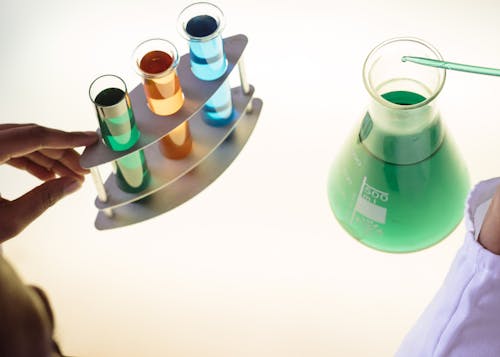
STOICHIOMETRY
EXERCISE SHORT QUESTIONS
Q1. 58.5 amu are termed as formula mass and not the molecular mass of NaCl. Why?
Because the term molecule is used for substances with covalent bonds, whereas NaCl is ionic. Therefore, we use "formula unit" instead of "molecule", so 58.5 amu is called the formula mass.
Q2. Concept of limiting reactant does not apply to the reversible reactions, why?
In reversible reactions, reactants are not fully consumed since they are regenerated during the reverse reaction. Therefore, no limiting reactant is defined.
Q3. Differentiate between limiting and non-limiting reactants?
Limiting Reactant:
Present in lesser amount, consumed first, limits the product formed.
Non-Limiting Reactant:
Present in excess, some amount remains unreacted.
Present in lesser amount, consumed first, limits the product formed.
Non-Limiting Reactant:
Present in excess, some amount remains unreacted.
Q4. What are stoichiometric amounts?
They represent the exact ratios of moles of reactants and products as shown in a balanced chemical equation.
For example: N2 + 3H2 → 2NH3
1 mole of N2 (28g) reacts with 3 moles of H2 (6g) to give 2 moles of NH3 (34g).
1 mole of N2 (28g) reacts with 3 moles of H2 (6g) to give 2 moles of NH3 (34g).
Q5. What are representative particles in one mole of a gas at S.T.P?
At S.T.P, one mole of a gas contains 6.02 × 1023 particles in 22.414 dm3 of volume.
Q6. The actual yield is less than the theoretical yield. Give reasons.
- Impurities in reactants
- Side reactions
- Reversible nature of some reactions
- Mechanical losses (e.g. during filtration)
- Human error
Q7. What is the relationship between mass and volume of a gas at S.T.P?
At S.T.P, 1 mole of any gas occupies 22.414 dm3 (1 dm3 = 1 litre).
Q8. What is the conversion factor?
It is the mole ratio of reactants and products in a balanced equation.
For example: C3H8 + 5O2 → 3CO2 + 4H2O
Mole ratios like 1:5:3:4 are conversion factors.
Mole ratios like 1:5:3:4 are conversion factors.
Q9. Define theoretical yield and actual yield?
Theoretical Yield:
The calculated maximum amount of product expected from a reaction.
Actual Yield:
The amount of product obtained from the actual experiment.
The calculated maximum amount of product expected from a reaction.
Actual Yield:
The amount of product obtained from the actual experiment.
Q10. What is a limiting reactant? How would you determine it?
The limiting reactant is completely consumed first and limits the product formed.
Steps to determine:
Steps to determine:
- Calculate moles of each reactant.
- Use the balanced equation to find mole ratios.
- The reactant producing less product is the limiting reactant.
Q11. How many molecules of water are there in 12g of ice?
\[ \text{1 mole of H}_{2}O = 18.016g \]
\[ \text{6.02 × 10}^{23} \text{ molecules in 18.016g} \]
\[ \text{12g} = \frac{6.02 × 10^{23}}{18.016} × 12 \approx 4 × 10^{23} \text{ molecules} \]
\[ \text{6.02 × 10}^{23} \text{ molecules in 18.016g} \]
\[ \text{12g} = \frac{6.02 × 10^{23}}{18.016} × 12 \approx 4 × 10^{23} \text{ molecules} \]
Q12. How many covalent bonds are present in 9g of H2O?
\[ \text{Mass of H}_{2}O = 9g \]
\[ \text{Molar Mass} = 18g \Rightarrow \text{0.5 moles} \]
\[ \text{1 molecule has 2 covalent bonds} \]
\[ \text{0.5 moles} = 0.5 × 6.02 × 10^{23} = 3.01 × 10^{23} \text{ molecules} \]
\[ \text{Total bonds} = 3.01 × 10^{23} × 2 = 6.02 × 10^{23} \text{ covalent bonds} \]
\[ \text{Molar Mass} = 18g \Rightarrow \text{0.5 moles} \]
\[ \text{1 molecule has 2 covalent bonds} \]
\[ \text{0.5 moles} = 0.5 × 6.02 × 10^{23} = 3.01 × 10^{23} \text{ molecules} \]
\[ \text{Total bonds} = 3.01 × 10^{23} × 2 = 6.02 × 10^{23} \text{ covalent bonds} \]
🔗 Other Useful Links
© 2025 AmurChem. All rights reserved.
Tags
Federal Board Chemistry
Formula Mass
Grade 11 Chemistry
limiting reactant
mole concept
NBF Chemistry
PTB Chemistry
Short Questions and Answers
Stoichiometry Questions
theoretical yield





